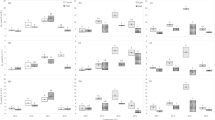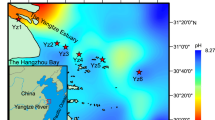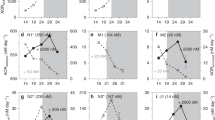Abstract
Temperature is one of the fundamental environmental variables governing microbially mediated denitrification and anaerobic ammonium oxidation (anammox) in sediments. The GHG nitrous oxide (N2O) is produced during denitrification, but not by anammox, and knowledge of how these pathways respond to global warming remains limited. Here, we show that warming directly stimulates denitrification-derived N2O production and that the warming response for N2O production is slightly higher than the response for denitrification in subtropical sediments. Moreover, denitrification had a higher optimal temperature than anammox. Integrating our data into a global compilation indicates that denitrifiers are more thermotolerant, whereas anammox bacteria are relatively psychrotolerant. Crucially, recent summer temperatures in low-latitude sediments have exceeded the optimal temperature of anammox, implying that further warming may suppress anammox and direct more of the nitrogen flow towards denitrification and associated N2O production, leading to a positive climate feedback at low latitudes.
This is a preview of subscription content, access via your institution
Access options
Access Nature and 54 other Nature Portfolio journals
Get Nature+, our best-value online-access subscription
$29.99 / 30 days
cancel any time
Subscribe to this journal
Receive 12 print issues and online access
$209.00 per year
only $17.42 per issue
Buy this article
- Purchase on Springer Link
- Instant access to full article PDF
Prices may be subject to local taxes which are calculated during checkout





Similar content being viewed by others
Data availability
The data that support the findings of this study can be requested from the corresponding author upon request.
References
Battye, W., Aneja, V. P. & Schlesinger, W. H. Is nitrogen the next carbon? Earth’s Future 5, 894–904 (2017).
Rockstrom, J. A safe operating space for humanity. Nature 461, 472–475 (2009).
Cox, P. M., Betts, R. A., Jones, C. D., Spall, S. A. & Totterdell, I. J. Acceleration of global warming due to carbon-cycle feedbacks in a coupled climate model. Nature 408, 184–187 (2000).
Galloway, J. N. et al. The nitrogen cascade. Bioscience 53, 341–356 (2003).
Field, C. B. & Barros, V. R. Added value from IPCC approval sessions. Science 350, 36 (2015).
Bellard, C., Bertelsmeier, C., Leadley, P., Thuiller, W. & Courchamp, F. Impacts of climate change on the future of biodiversity. Ecol. Lett. 15, 365–377 (2012).
Magozzi, S. & Calosi, P. Integrating metabolic performance, thermal tolerance, and plasticity enables for more accurate predictions on species vulnerability to acute and chronic effects of global warming. Glob. Change Biol. 21, 181–194 (2015).
Allison, S. D. & Treseder, K. K. Warming and drying suppress microbial activity and carbon cycling in boreal forest soils. Glob. Change Biol. 14, 2898–2909 (2008).
Gudasz, C. et al. Temperature-controlled organic carbon mineralization in lake sediments. Nature 466, 478–481 (2010).
Duan, S. W. & Kaushal, S. S. Warming increases carbon and nutrient fluxes from sediments in streams across land use. Biogeosciences 10, 1193–1207 (2013).
Seitzinger, S. et al. Denitrification across landscapes and waterscapes: a synthesis. Ecol. Appl. 16, 2064–2090 (2006).
Kuypers, M. M. M., Marchant, H. K. & Kartal, B. The microbial nitrogen-cycling network. Nat. Rev. Microbiol. 16, 263–276 (2018).
Zhu, G. et al. Anaerobic ammonia oxidation in a fertilized paddy soil. ISME J. 5, 1905–1912 (2011).
Peng, X. et al. Long‐term fertilization alters the relative importance of nitrate reduction pathways in salt marsh sediments. J. Geophys. Res. Biogeosci. 121, 2082–2095 (2016).
Koriyama, M., Koga, A., Seguchi, M. & Ishitani, T. Factors controlling denitrification of mudflat sediments in Ariake Bay, Japan. Environ. Monit. Assess. 188, 1–14 (2016).
Devol, A. H. Denitrification, anammox, and N2 production in marine sediments. Annu. Rev. Mar. Sci. 7, 403–423 (2015).
Engström, P., Penton, C. R. & Devola, A. H. Anaerobic ammonium oxidation in deep‐sea sediments off the Washington margin. Limnol. Oceanogr. 54, 1643–1652 (2009).
Trimmer, M. & Nicholls, J. C. Production of nitrogen gas via anammox and denitrification in intact sediment cores along a continental shelf to slope transect in the North Atlantic. Limnol. Oceanogr. 54, 577–589 (2009).
Brin, L. D., Giblin, A. E. & Rich, J. J. Environmental controls of anammox and denitrification in southern New England estuarine and shelf sediments. Limnol. Oceanogr. 59, 851–860 (2014).
Crowe, S. A., Canfield, D. E., Mucci, A., Sundby, B. & Maranger, R. Anammox, denitrification and fixed-nitrogen removal in sediments from the Lower St. Lawrence Estuary. Biogeosciences 9, 4309–4321 (2012).
Tan, E., Hsu, T.-C., Huang, X., Lin, H.-J. & Kao, S.-J. Nitrogen transformations and removal efficiency enhancement of a constructed wetland in subtropical Taiwan. Sci. Total Environ. 601–602, 1378–1388 (2017).
Canion, A. et al. Temperature response of denitrification and anammox reveals the adaptation of microbial communities to in situ temperatures in permeable marine sediments that span 50° in latitude. Biogeosciences 11, 309–320 (2014).
Rich, J. J., Dale, O. R., Song, B. & Ward, B. B. Anaerobic ammonium oxidation (anammox) in Chesapeake Bay sediments. Microb. Ecol. 55, 311–320 (2008).
Teixeira, C., Magalhaes, C., Joye, S. B. & Bordalo, A. A. Potential rates and environmental controls of anaerobic ammonium oxidation in estuarine sediments. Aquat. Microb. Ecol. 66, 23–32 (2012).
McTigue, N. D., Gardner, W. S., Dunton, K. H. & Hardison, A. K. Biotic and abiotic controls on co-occurring nitrogen cycling processes in shallow Arctic shelf sediments. Nat. Commun. 7, 13145 (2016).
Brin, L. D., Giblin, A. E. & Rich, J. J. Similar temperature responses suggest future climate warming will not alter partitioning between denitrification and anammox in temperate marine sediments. Glob. Change Biol. 23, 331–340 (2017).
Canion, A. et al. Temperature response of denitrification and anaerobic ammonium oxidation rates and microbial community structure in Arctic fjord sediments. Environ. Microbiol. 16, 3331–3344 (2014).
Dalsgaard, T. & Thamdrup, B. Factors controlling anaerobic ammonium oxidation with nitrite in marine sediments. Appl. Environ. Microbiol. 68, 3802–3808 (2002).
Rysgaard, S., Glud, R. N., Risgaard-Petersen, N. & Dalsgaard, T. Denitrification and anammox activity in Arctic marine sediments. Limnol. Oceanogr. 49, 1493–1502 (2004).
Myrstener, M., Jonsson, A. & Bergstrom, A. K. The effects of temperature and resource availability on denitrification and relative N2O production in boreal lake sediments. J. Environ. Sci. 47, 82–90 (2016).
Smith, K. A., Thomson, P. E., Clayton, H., Mctaggart, I. P. & Conen, F. Effects of temperature, water content and nitrogen fertilisation on emissions of nitrous oxide by soils. Atmos. Environ. 32, 3301–3309 (1998).
Parkin, T. B. & Kaspar, T. C. Nitrous oxide emissions from corn–soybean systems in the midwest. J. Environ. Qual. 35, 1496 (2006).
Kawagoshi, Y., Fujisaki, K., Tomoshige, Y., Yamashiro, K. & Wei, Q. Temperature effect on nitrogen removal performance and bacterial community in culture of marine anammox bacteria derived from sea-based waste disposal site. J. Biosci. Bioeng. 113, 515–520 (2012).
Pfenning, K. S. & McMahon, P. B. Effect of nitrate, organic carbon, and temperature on potential denitrification rates in nitrate-rich riverbed sediments. J. Hydrol. 187, 283–295 (1996).
Boulêtreau, S., Salvo, E. & Lyautey, E. Temperature dependence of denitrification in phototrophic river biofilms. Sci. Total Environ. 416, 323–328 (2012).
Jørgensen, C. J., Ole Stig, J., Bo, E. & Jens, A. Microbial oxidation of pyrite coupled to nitrate reduction in anoxic groundwater sediment. Environ. Sci. Technol. 43, 4851–4857 (2009).
Ambus, P. Control of denitrification enzyme activity in a streamside soil. FEMS Microbiol. Lett. 102, 225–234 (1993).
Palacin-Lizarbe, C., Camarero, L. & Catalan, J. Denitrification temperature dependence in remote, cold and N-poor lake sediments. Water Resour. Res. 54, 1161–1173 (2018).
Warneke, S., Schipper, L. A., Bruesewitz, D. A., Mcdonald, I. & Cameron, S. Rates, controls and potential adverse effects of nitrate removal in a denitrification bed. Ecol. Eng. 37, 511–522 (2011).
Kuenen, J. G. Extraordinary anaerobic ammonium-oxidizing bacteria. ASM News 67, 456–462 (2001).
Strous, M., Kuenen, J. G. & Jetten, M. S. Key physiology of anaerobic ammonium oxidation. Appl. Environ. Microbiol. 65, 3248–3250 (1999).
Morita, R. Y. Psychrophilic bacteria. Bacteriol. Rev. 39, 144–167 (1975).
Isaksen, M. F. & Jorgensen, B. B. Adaptation of psychrophilic and psychrotrophic sulfate-reducing bacteria to permanently cold marine environments. Appl. Environ. Microbiol. 62, 408–414 (1996).
Pinsky, M. L., Eikeset, A. M., McCauley, D. J., Payne, J. L. & Sunday, J. M. Greater vulnerability to warming of marine versus terrestrial ectotherms. Nature 569, 108–111 (2019).
King, D. & Nedwell, D. B. Changes in the nitrate-reducing community of an anaerobic saltmarsh sediment in response to seasonal selection by temperature. Microbiology 130, 2935–2941 (1984).
Veraart, A. J., de Klein, J. J. & Marten, S. Warming can boost denitrification disproportionately due to altered oxygen dynamics. PLoS ONE 6, e18508 (2011).
Hallin, S. et al. Soil functional operating range linked to microbial biodiversity and community composition using denitrifiers as model guild. PLoS ONE 7, e51962 (2012).
Bestion, E., Schaum, C. E. & Yvon-Durocher, G. Nutrient limitation constrains thermal tolerance in freshwater phytoplankton. Limnol. Oceanogr. Lett. 3, 436–443 (2018).
Greaver, T. L. et al. Key ecological responses to nitrogen are altered by climate change. Nat. Clim. Change 6, 836–843 (2016).
Xue, K. et al. Tundra soil carbon is vulnerable to rapid microbial decomposition under climate warming. Nat. Clim. Change 6, 595–600 (2016).
Zhou, J. et al. Microbial mediation of carbon-cycle feedbacks to climate warming. Nat. Clim. Change 2, 106–110 (2011).
Tscherko, D., Kandeler, E. & Jones, T. H. Effect of temperature on below-ground N-dynamics in a weedy model ecosystem at ambient and elevated atmospheric CO2 levels. Soil Biol. Biochem. 33, 491–501 (2001).
Cao, W., Huang, Z., Zhai, W., Li, Y. & Hong, H. Isotopic evidence on multiple sources of nitrogen in the northern Jiulong River, Southeast China. Estuar. Coast. Shelf Sci. 163, 37–43 (2015).
Hong, Q., Cai, P., Shi, X., Li, Q. & Wang, G. Solute transport into the Jiulong River estuary via pore water exchange and submarine groundwater discharge: new insights from 224Ra/228Th disequilibrium. Geochim. Cosmochim. Acta 198, 338–359 (2016).
Chen, N., Hong, H., Zhang, L. & Cao, W. Nitrogen sources and exports in an agricultural watershed in Southeast China. Biogeochemistry 87, 169–179 (2008).
Yan, X. et al. Distribution, fluxes and decadal changes of nutrients in the Jiulong River Estuary, Southwest Taiwan Strait. Chin. Sci. Bull. 57, 2307–2318 (2012).
Thamdrup, B. & Dalsgaard, T. Production of N2 through anaerobic ammonium oxidation coupled to nitrate reduction in marine sediments. Appl. Environ. Microbiol. 68, 1312–1318 (2002).
Tan, E. et al. Organic matter decomposition sustains sedimentary nitrogen loss in the Pearl River Estuary, China. Sci. Total Environ. 648, 508–517 (2019).
Kao, S. J., Liu, K. K., Hsu, S. C., Chang, Y. P. & Dai, M. H. North Pacific-wide spreading of isotopically heavy nitrogen during the last deglaciation: evidence from the western Pacific. Biogeosciences 5, 1641–1650 (2008).
Braman, R. S. & Hendrix, S. A. Nanogram nitrite and nitrate determination in environmental and biological materials by vanadium (III) reduction with chemiluminescence detection. Anal. Chem. 61, 2715–2718 (1989).
Zheng, Z. Z. et al. Effects of temperature and particles on nitrification in a eutrophic coastal bay in southern China. J. Geophys. Res. 122, 2325–2337 (2017).
Hsu, T. C. & Kao, S. J. Simultaneous measurement of sedimentary N2 and N2O production and a modified 15N isotope pairing technique. Biogeosciences 10, 7847–7862 (2013).
Brown, J. H., Gillooly, J. F., Allen, A. P., Savage, V. M. & West, G. B. Toward a metabolic theory of ecology. Ecology 85, 1771–1789 (2004).
Perkins, D. M. et al. Consistent temperature dependence of respiration across ecosystems contrasting in thermal history. Glob. Change Biol. 18, 1300–1311 (2012).
Acknowledgements
This study was supported by the National Natural Science Foundation of China (NSFC no. 91851209, 41721005, 41561164019 and 41806092). This is State Key Laboratory of Marine Environment Science contribution no. melpublication2019349. J.J.M. was supported by the Netherlands Earth System Science Center. Special acknowledgment to intensive field and laboratory work by J. C. Xu.
Author information
Authors and Affiliations
Contributions
E.T. and S.-j.K. conceived the study and designed the experiment; E.T., W.Z., M.D. and L.T. performed the experiment and measured the samples; E.T., M.D., T.-C.H., L.T. and S.-j.K. analysed the data; E.T., Z.Z., X.Y., T.-C.H., J.J.M., T.W.T. and S.-j.K. contributed to the discussion of the results and wrote the manuscript.
Corresponding author
Ethics declarations
Competing interests
The authors declare no competing interests.
Additional information
Peer review information Nature Climate Change thanks Rachel Horak, Jeremy Rich and Mark Trimmer for their contribution to the peer review of this work.
Publisher’s note Springer Nature remains neutral with regard to jurisdictional claims in published maps and institutional affiliations.
Supplementary information
Supplementary Information
Supplementary results, discussion, Figs. 1–8, Tables 1–8 and references.
Source data
Source Data Fig. 1
Numerical data.
Source Data Fig. 2
Numerical data.
Source Data Fig. 3
Numerical data.
Source Data Fig. 4
Numerical data.
Source Data Fig. 5
Numerical data.
Rights and permissions
About this article
Cite this article
Tan, E., Zou, W., Zheng, Z. et al. Warming stimulates sediment denitrification at the expense of anaerobic ammonium oxidation. Nat. Clim. Chang. 10, 349–355 (2020). https://doi.org/10.1038/s41558-020-0723-2
Received:
Accepted:
Published:
Issue Date:
DOI: https://doi.org/10.1038/s41558-020-0723-2
This article is cited by
-
Ocean acidification offsets the effect of warming on sediment denitrification and associated nitrous oxide production
Communications Earth & Environment (2024)
-
Warming Tends to Promote Nitrogen Conservation but Stimulate N2O Emissions in Mangrove Sediments
Ecosystems (2024)
-
Universal temperature sensitivity of denitrification nitrogen losses in forest soils
Nature Climate Change (2023)
-
Comparison of Nitrate and Ammonium Leaching of Soils Collected from Different Regions of China: A Soil Column Experiment
Journal of Soil Science and Plant Nutrition (2023)
-
Sedimentary nitrogen dynamics in a coastal reef area with relatively high nitrogen concentration
Acta Oceanologica Sinica (2023)



